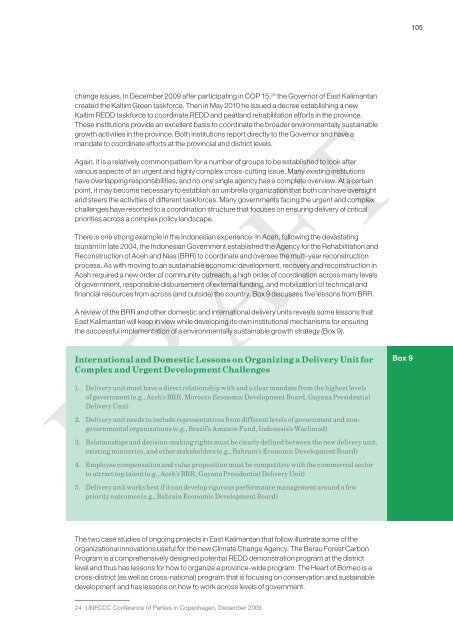East Kalimantan Environmentally Sustainable Development Strategy
East Kalimantan Environmentally Sustainable Development Strategy
East Kalimantan Environmentally Sustainable Development Strategy
Create successful ePaper yourself
Turn your PDF publications into a flip-book with our unique Google optimized e-Paper software.
105<br />
change issues. In December 2009 after participating in COP 15, 24 the Governor of <strong>East</strong> <strong>Kalimantan</strong><br />
created the Kaltim Green taskforce. Then in May 2010 he issued a decree establishing a new<br />
Kaltim REDD taskforce to coordinate REDD and peatland rehabilitation efforts in the province.<br />
These institutions provide an excellent basis to coordinate the broader environmentally sustainable<br />
growth activities in the province. Both institutions report directly to the Governor and have a<br />
mandate to coordinate efforts at the provincial and district levels.<br />
Again, it is a relatively common pattern for a number of groups to be established to look after<br />
various aspects of an urgent and highly complex cross-cutting issue. Many existing institutions<br />
have overlapping responsibilities, and no one single agency has a complete overview. At a certain<br />
point, it may become necessary to establish an umbrella organization that both can have oversight<br />
and steers the activities of different taskforces. Many governments facing the urgent and complex<br />
challenges have resorted to a coordination structure that focuses on ensuring delivery of critical<br />
priorities across a complex policy landscape.<br />
There is one strong example in the Indonesian experience. In Aceh, following the devastating<br />
tsunami in late 2004, the Indonesian Government established the Agency for the Rehabilitation and<br />
Reconstruction of Aceh and Nias (BRR) to coordinate and oversee the multi-year reconstruction<br />
process. As with moving to an sustainable economic development, recovery and reconstruction in<br />
Aceh required a new order of community outreach, a high order of coordination across many levels<br />
of government, responsible disbursement of external funding, and mobilization of technical and<br />
financial resources from across (and outside) the country. Box 9 discusses five lessons from BRR.<br />
A review of the BRR and other domestic and international delivery units reveals some lessons that<br />
<strong>East</strong> <strong>Kalimantan</strong> will keep in view while developing its own institutional mechanisms for ensuring<br />
the successful implementation of a environmentally sustainable growth strategy (Box 9).<br />
International and Domestic Lessons on Organizing a Delivery Unit for<br />
Complex and Urgent <strong>Development</strong> Challenges<br />
1.<br />
2.<br />
3.<br />
Delivery unit must have a direct relationship with and a clear mandate from the highest levels<br />
of government (e.g., Aceh’s BRR, Morocco Economic <strong>Development</strong> Board, Guyana Presidential<br />
Delivery Unit)<br />
DRAFT<br />
Delivery unit needs to include representatives from different levels of government and nongovernmental<br />
organizations (e.g., Brazil’s Amazon Fund, Indonesia’s Waclimad)<br />
Relationships and decision-making rights must be clearly defined between the new delivery unit,<br />
existing ministries, and other stakeholders (e.g., Bahrain’s Economic <strong>Development</strong> Board)<br />
4. Employee compensation and value proposition must be competitive with the commercial sector<br />
to attract top talent (e.g., Aceh’s BRR, Guyana Presidential Delivery Unit)<br />
5.<br />
Delivery unit works best if it can develop rigorous performance management around a few<br />
priority outcomes (e.g., Bahrain Economic <strong>Development</strong> Board)<br />
Box 9<br />
The two case studies of ongoing projects in <strong>East</strong> <strong>Kalimantan</strong> that follow illustrate some of the<br />
organizational innovations useful for the new Climate Change Agency. The Berau Forest Carbon<br />
Program is a comprehensively designed potential REDD demonstration program at the district<br />
level and thus has lessons for how to organize a province-wide program. The Heart of Borneo is a<br />
cross-district (as well as cross-national) program that is focusing on conservation and sustainable<br />
development and has lessons on how to work across levels of government.<br />
24 UNFCCC Conference of Parties in Copenhagen, December 2009

















